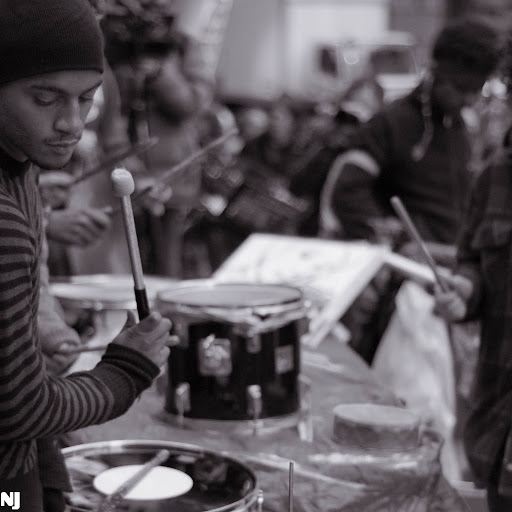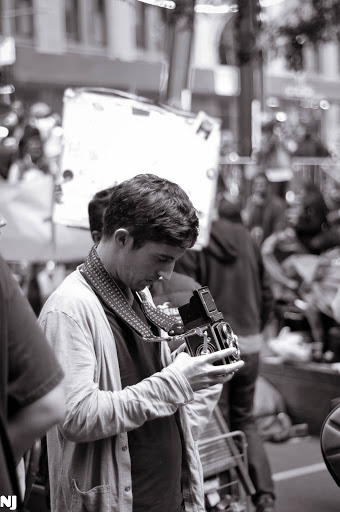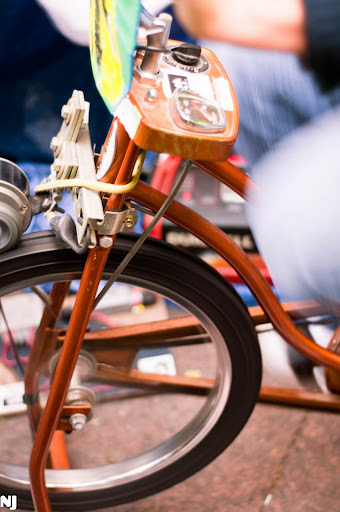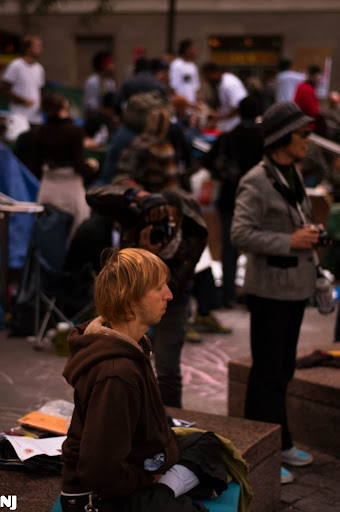
The role of new, social media in the Occupy protests near Wall Street, around the country and even around the globe is something I’ve written about before. I spent some time at Occupy Wall Street last week and talked to many folks there about technology. The story that emerged is much more complicated than expected. OWS has a more complicated, perhaps even “ironic” relationship with technology than I previous thought and that is often portrayed in the news and in everyday discussions.
It is easy to think of the Occupy protests as a bunch of young people who all blindly utilize Facebook, Twitter, SMS, digital photography and so on. And this is partially true. However, (1) not everyone at Occupy Wall Street is young; and (2), the role of technology is certainly not centered on the new, the high-tech or social media. At OWS, there is a focus on retro and analogue technologies; moving past a cultural fixation on the high-tech, OWS has opened a space for the low-tech.
What I want to think about there is the general Occupy Wall Street culture that has mixed-feelings about new technologies, even electricity itself. I will give examples of the embracing of retro-technology at OWS and consider three overlapping explanations for why this might be the case. I will also make use of some photographs I took while there.
Entering the Occupy Wall Street protests in Zuccotti Park, Manhattan, I was surprised how much old-school, retro, analogue and other “low-technologies” are embraced.

- The obvious and not-so-surprising example is the hand-painted signs that are so ubiquitous that they come to define a protest as separate from other types of gatherings.

- Importantly, there is the popular Occupied Wall Street Journal print newspaper. In the age of the so-called death-of-print, young people are designing, printing, trading and reading this print newspaper.
- The human-microphone (previous discussed on this blog), where the protesters chant what one person says so that the whole crowd can all hear (bullhorns have been outlawed at the park).

- The drum circles are an analogue technology that gets attention, attempts to build community (though, some argue that it does the opposite), and, this point hits home when you are actually at the park, drumming can keep you warm in cold weather.

- The expanding library filled with print books.


- Surprising to some might be all of the vintage cameras. Be they early-model Polaroid’s or old Kodak brownies, ancient cameras are popular at Occupy Wall Street. A statement that alone justifies this further analysis. Perhaps this trend is the analogue version of the popular faux-vintage smartphone photo apps like Instagram and Hipstamatic that I have written about before.

- I also saw this bike-generator, where the rider pedals power to various electronic devices.
- The Occupy Tourists have themselves been turned into a technology, something Rob Horning and I discussed while in the park (in fact, I probably owe him credit for this idea). The protesters do not necessarily have to hold the camera or post the photos any longer because the park is nearly over-run with people holding cameras; new and old, photo and video. The Occupy Tourists do the work of documenting, all the protesters have to do is pose (and they do; more on this below).

- And, of course, the whole movement to “occupy” means “occupying” physical space; the primary and very analogue form of protest we know best.
To be clear, I do not mean to say all technology at Occupy Wall Street is retro. There are laptops, a Wi-Fi network and smart phones uploading and responding to content across the web. Sometimes there is even a monitor/webcam setup that live-streams activity at the park (pictured below). Occupy utilizes both old and new technologies. And as I previously argued, they utilize both the on and offline; indeed this is an augmented revolution. However, the precise form of this technological augmentation needs to take into account how the OWS protests have an atemporal embracing of analogue and retro technologies and general distrust of the logic behind new technologies.

I spoke to many people at Occupy Wall Street about the technology situation in the park. I talked with various protesters and paid special attention to those dealing with technology and those whose role it was to provide general and press information. I should note that each person I talked to, be they a person who spends lots of time at the park or an “official” press contact, provided me with slightly different information; perhaps the result of the contradiction of having a spokesperson for a very decentralized group. However, as hours passed and people cycled through the park, I spoke to more and more individuals and a complicated picture developed.
I would hear two seemingly contradictory things, sometimes from the same person: (1) ‘I would be uploading more stuff to Facebook and Twitter if my phone was charged, but it is dead’; and (2) ‘we do not need electricity!’
So, why is this? Contradiction? Why the embracing of retro-tech? Does it have to do with ideology? Necessity? Both?
I want to provide three possible explanations. [*this list is not all-inclusive]
I. No Electricity, Duh
Perhaps the most obvious answer to why there is a love-hate relationship with new technologies has to do with the structural realities of the park itself; namely, the lack of electricity. There were some (at least 4) generators at the park when I was there. These were recently taken away and there is a fight to get them back. However, even with generators, electricity was sparse. The generators powered the media table (a modest amount of technology: laptops, printer, Wi-Fi router, webcam, TV) and charged some cell phones. Also, nearby food and newsstands were generally okay with letting protesters charge their phones (the protests are generating tourists and business in the area; I’ll have to force myself to leave ‘the commoditization of Occupy’ for another post).
But the story cannot be as simple as ‘there is little electricity so the protesters are using analogue tech.’ This does not explain why there is an embracing of analogue and why I was told over and over that “we don’t need electricity.”
Perhaps the structural reality (i.e., scarce electricity) has created a necessity to go analogue, which then has come to be embraced retroactively as something done intentionally? The ends required a new means, and now the means have come to be valued in and of themselves (to make a Simmelian argument).
A thought experiment: if electricity suddenly became abundant in Zuccotti Park, would more protesters be using their smart phones more of the time? Would there be more laptops open? I think so. In fact, I was told as much. However, would abundant electricity kill the retro-tech zeitgeist in the park? No, I do not think it would. And this is because there are other reasons for this mood.
II. It’s Politics: Rejecting the Logic of Consumer Technology Capitalism
To argue that the protesters embrace retro-technology only because there is little electricity misses the larger political reasoning that many, but probably not all, protesters in the park may have a general distrust of the role modern technology plays in our lives.
The contemporary logic of technology is a fixation on the high-tech: more, better, faster, smaller, cooler. All in the name of corporate profits. This has resulted in Apple’s treatment of workers in China, Google’s monopolistic, data-hungry capturing of more and more information, Facebook’s insidious creep into our private lives and the mounting piles of hazardous e-waste that we in the Global West export to the developing world. While new technologies are not fully abandoned at OWS, there is at least a questioning of the logic of new, shiny tech-toys as it relates to all of these growing problems.
There is the general mood at Zuccotti Park that humans are the most important technology that we have and that we live in a culture where we have become subservient to non-human technologies rather than the other way around. Instead, people, bodies and physical space are prioritized at the park. And when technology is needed, the embracing of low-technologies becomes a symbolic statement against this logic of high-technology-driven consumer capitalism.
For example, when engaging in the human-microphone, one quickly realizes that it becomes more than just a substitute for bullhorns, microphones and speakers. It becomes a powerful form of solidarity, it is a spectacle that gets the attention of the Occupy Tourists and it comes to stand for the resistance of the movement itself.
I should admit that no one protester told me all of this in plain language. This is my own extrapolation based on my general feeling of the protests and I invite others to disagree with me here. I think it is a plausible explanation given what Occupy is all about, but cannot claim I heard this directly from the protesters in any systematic way. More research would need to be done on this point.
III. Protesters Need Only to Pose

A third explanation for why there exists a love-hate relationship with new technologies at OWS goes back to one of the bulleted points above: those in Zuccotti park do not have to document themselves as much anymore because there is a crowd to do that for them. Again, tourists, journalists and other visitors have themselves been appropriated as a technology of documentation.
So much new, digital and social technologies center on documentation. A photo, status update, tweet, and the rest all are about documenting something: voicing your opinion, spreading news, giving detail or passing some other kind of information around. When the Occupy Wall Street protests were smaller, and this is still the case with most regional Occupations, the protesters themselves were organizing on Facebook, spreading the word with Twitter hashtags and shooting photos and videos of their numbers and suspected police brutality.
Things have changed a bit for OWS. Today, Zuccotti Park is a major tourist destination. Massive crowds with fully-charged cameras are snapping away. Journalists and other interested parties have increasingly been documenting the movement. And there are loads of photographers around every corner shooting the scene (I was one of them). Occupy Wall Street has much of the attention they asked for and this has positioned themselves on the other side of the camera lens.
And this is why the protesters have gotten very good at posing. The drum circle is set up facing the crowd of tourists; separated by a metal gate just like a rock concert. They drum, put on their show, and people stand at the gates with cameras. One scene I saw over and over again in the park was a protester seeing someone point a camera at them and immediately freeze staring off into space. The protester attempts to pose as unposed, the camera-person attempts to pass the photo off as spontaneous. Simply put, the protesters are very aware that their every move is being documented and react accordingly. Like reality show contestants or modern famous-for-being-famous celebrities, those in Zuccotti Park adhere to the logic of ubiquitous cameras by becoming photogenic.
To be clear, I say none of this as a put-down to the protestors. I know that, typically, “posing” is a word used pejoratively (“poser” is an insult). However, it strikes me that the protesters are effectively using the power of the gaze: they use the power inherent in being watched to portray what they want. Lacking electricity, the OWS protesters have turned tourists into Twitter. Instead of having to shoot their own photos, post them and hope for an audience, the OWS protester learns instead to be photogenic, luring the cameraperson to compose, snap, post and disseminate; an efficient and effective strategy in the image-economy.
To conclude, all of this is only my initial speculations about the very interesting role technology plays in the Occupy Wall Street protests. The technology of the movement is not just how they have utilized the new and the high tech but also the embracing of low-technologies. Much more could be said and other perspectives should be entertained. Further, it must be the case that all of this plays out quite differently at different local Occupy protests. Hopefully that is a discussion we can have on this blog in the near future.
follow nathan on Twitter: @nathanjurgenson




Comments 18
Will — November 2, 2011
Fascinating perspective.
Sunny Moraine — November 2, 2011
For what it's worth, I did have a few people in Chicago tell me explicitly that they felt that Occupy was providing them with face-to-face connection that they had been lacking, and they placed the blame for this pretty squarely on preoccupation with technology. I didn't have time to tease this out in more in-depth conversations, but when I pointed out the role that social media has played in the protests, they conceded that technology should be looked at as merely a tool, and positive or negative depending on its use.
So there is definitely some interesting ambivalence here. I think your feeling regarding a push-back against consumer tech is probably correct in a significant number of cases. A common theme in so much of the discourse I've seen is the reclamation of lost/repressed humanity--from every form of authority and every system of power. It makes perfect sense that one's relationship with technology would fall into the heart of that.
@hautepop — November 2, 2011
Hmm. I'd want to be very very careful to avoid conflating "retro" and "analogue" technologies. It's also important to avoid oversimplistic hierarchical thinking along the lines of 'digital technology = high tech = better / analogue = low-tech = worse".
Choosing to use analogue tech at a protest may be simply practical rather than choosing deliberate difficulty to make a retro or anti-digi-tech statement. Occam's razor and all...
E.g. cardboard signs - well what is the digital alternative? A projector? Not very visible in daylight. Some electronic screen? Cumbersome and expensive. People are surely using card signs because they are quicker, cheaper and more visible - in a word, better for the situation at hand.
Likewise with the library: people already own books. They're more sharable than e-books, they're more robust, they're cheaper... Hell, there are a lot of homeless and unemployed people involved in the occupations - a Kindle's hardly going to be many people's first-choice option!
Bike generators: in a situation where you're not allowed any other kind of generators, how is this not a pragmatic fix (or arguably a hack)?
On the camera side of things you may well have an argument, but I'm wary of conflating it to the level of technology & comms in general
Chris Watkins — November 4, 2011
Love the human bullhorn!
I think Lonny from Appropedia might have had something to do with the bike generators - he mentioned they were on their way to the park. Certainly they've been documented on Appropedia for quite a while, along with a bunch of other appropriate technology.
Some relevant tech is documented at http://www.appropedia.org/Occupy_Sustainability (and there's a link to this article). Don't know that you'd get away with setting up a hexayurt or composting toilet, but it's all cool tech anyway.
Retro-Tech: #OWS’ Complicated Relationship with Technology « n a t h a n j u r g e n s o n — November 4, 2011
[...] This was originally posted at my blog Cyborgology – click here to view the original post and to re... all photos in this post by nathan jurgenson [...]
You, Me, Them, Everybody – 11/6/11, News with Esmeralda Leon, Technology at the #occupy Protests with Nathan Jurgenson, Hosting an Open Mic with Peter Heyneman — November 7, 2011
[...] Nathan explains just what type of technology one can find at Occupy Wall Street. Read his article here. [...]
The Future of the #Occupy Movement (in Memes) » Cyborgology — November 24, 2011
[...] endurance. Occupiers have been adept at leveraging mobile computing and social media technologies (as well as tourists!) to ensure that an abundance of content circulates both virally and through traditional media [...]
The Future of the #Occupy Movement (in Memes) « PJ Rey's Sociology Blog Feed — November 24, 2011
[...] endurance. Occupiers have been adept at leveraging mobile computing and social media technologies (as well as tourists!) to ensure that an abundance of content circulates both virally and through traditional media [...]
Hipster Rivivalism: Authentic Technologies of Days Gone Past » Cyborgology — November 25, 2011
[...] of days gone past. For example, the rising popularity of the vintage photography equipment, the proliferation of “retro-tech” at #Occupy, a variety of online blogs (such as this one), the re-birth of vinyl, [...]
Benvenuti nell’era delle rivoluzioni augmeted | Societing — November 30, 2011
[...] respirando, dormendo e facendo quello che si va nella concretezza. C’è chiaramente un abbraccio di low-tech a Occupare Wall Street, dove le tecnologie retrò e analogiche aumentare le high-tech al [...]
Analogue and New Technologies in OWS | BiblioShock — December 9, 2011
[...] Jurgenson’s article: “Retro-Tech: #OWS’ Complication Relationship with Technology,” reports that there are both new and surprisingly old technologies at work in the OWS movement, not [...]
Occupy Wall Street is Opening Doors | Occupy Wall Street Analysis — May 3, 2012
[...] working on technological advances, some don’t even feel electricity is necessary. Writer Nathan Jurgenson theorizes why this is by claiming, “There is the general mood at Zuccotti Park that humans are [...]
The IRL Fetish « n a t h a n j u r g e n s o n — July 20, 2012
[...] The current obsession with the analog, the vintage, and the retro has everything to do with this fetishization of the offline. The rise of the mp3 has been coupled with a resurgence in vinyl. Vintage cameras and typewriters dot the apartments of Millennials. Digital photos are cast with the soft glow, paper borders, and scratches of Instagram’s faux-vintage filters. The ease and speed of the digital photo resists itself, creating a new appreciation for slow film photography. “Decay porn” has become a thing. At Occupy Wall Street, there was a bunch of old-time-y cameras [...]